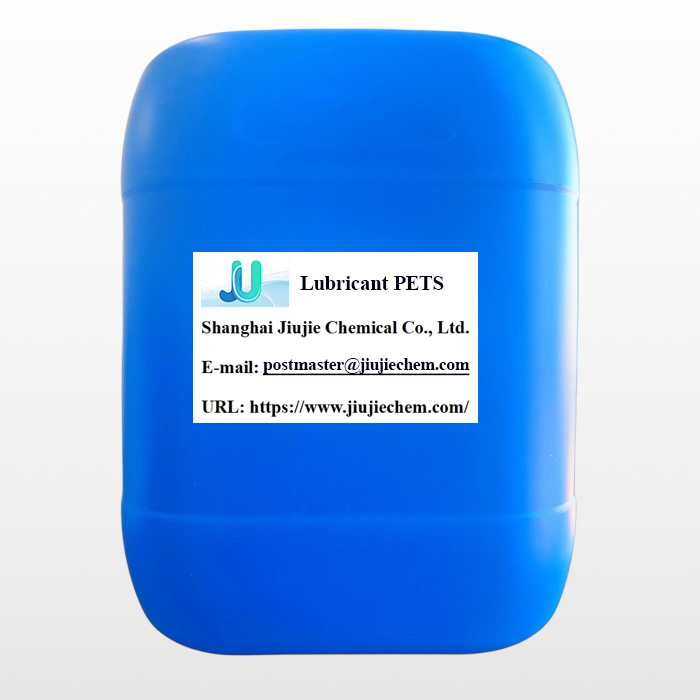Lubricant PETS
Get a quote

Product Description:
Lubricant PETS, abbreviated as PETS, is a white hard wax or powder substance that is soluble in ethanol and benzene.
Molecular formula:C77H148O8
Molecular weight:1201.99
CAS number:115-83-3
Product indicators:
Project | PETS-3 | PETS-4 | PETS-4-1 |
Acid value(mgKOH/g) | ≤5 | ≤5 | ≤5 |
Iodine number (gI2/100g) | ≤2 | ≤2 | ≤2 |
Hydroxyl value(mgKOH/g) | 55-65 | 25-35 | ≤12 |
Koettstorfer number(mgKOH/g) | 185-195 | 185-195 | 185-205 |
Melting point(℃) | 50-60 | 55-66 | 60-70 |
Product use:
PETS is used as a plasticizer, lubricant, dispersant, and release agent in the rubber and plastic industries. PETS has good thermal stability and low volatility, good mold release and flow properties, and plays a role of lubrication and mold release in the processing and modification of thermoplastic engineering plastics such as PC, PC/ABS, PBT, PET, PA66; in plastic color masterbatch As internal and external lubricants and dispersants in granules and functional masterbatches, it can promote the dispersion of toner and fillers, and significantly improve the surface finish of particles; it can lubricate, disperse, and release molds in rubber processing and mixing, and improve the friction of rubber materials. Force and adhesion, increasing speed. The typical dosage is 0.1-1%, which is lower than most traditional lubricants. PETS-4-1 can withstand a high temperature of 400°C, is not easy to decompose, will not cause discoloration of the product, and can improve the brightness of the product.
1. Application in engineering plastics.
(1) Application in PC, PC/ABS, PA6, PA66, PBT and other engineering plastic products.
Product efficacy: special lubricating and dispersing additive for plastic and rubber, with good dispersibility, mainly used for extrusion, injection molding and calendering of PVC, PE, PP, PS, ABS, PET, PA and other polymers. Improve the processing fluidity of the melt, reduce energy consumption and improve production efficiency. Improve melt strength and melt fracture; increase inorganic fillers (calcium carbonate, talcum powder, wood powder, etc.) Impact strength reduced by inorganic substances. Improve the smoothness of the product, prevent and overcome the sticking problem, and improve the processability of the product. Improve product finish, brightness and surface smoothness. Note: Addition amount: 0.5%-3%.
(2) Application in functional plastic masterbatch and color masterbatch.
Product efficacy: Excellent dispersion effect in the preparation of PC/ABS, PET, PBT, PPS, and PC color masterbatches; PETS-4 is also an excellent performance for many types of modified engineering plastic functional masterbatches of lubricants. For example, in concentrated filler masterbatches, color masterbatches and flame retardant masterbatch formulations, it can promote the uniform dispersion of pigments, fillers or flame retardants. Compared with EBS, it has the advantages of excellent high temperature resistance, balanced internal and external lubrication and not easy to precipitate. PETS-4 is an excellent shrink film opening agent, brightener and auxiliary plasticizer. Note: Addition amount: 1-10%.
(3) Application in nylon insulation strips.
In fiber-reinforced polyamide nylon insulation strips, PETS is also widely used as an anti-glass fiber leakage agent and lubricating and dispersing agent, which can greatly improve the floating fiber phenomenon.
2. As a processing aid (dispersant, lubricant) in rubber pre-dispersed masterbatches.
The main types of common rubber are: natural rubber (NR), ethylene propylene rubber (EPM\\EPDM), styrene-butadiene rubber (SBR), butadiene rubber (BR), nitrile rubber (NBR), etc. Ethylene propylene rubber is generally divided into two yuan ethylene propylene rubber and three yuan ethylene propylene rubber. It is characterized by excellent ozone resistance, ultraviolet resistance, weather resistance and aging resistance, ranking first among general-purpose rubbers. Good electrical insulation, chemical resistance, impact elasticity, acid and alkali resistance, small specific gravity, and high filling and matching. Rubber pre-dispersed masterbatches Currently common types of pre-dispersed masterbatches include zinc oxide pre-dispersed masterbatch (ZN0-80), insoluble sulfur pre-dispersed masterbatch (S-80), accelerator pre-dispersed masterbatch (MBT-80 , TMTM-80, TMTD-80, etc.).
The general predispersed masterbatch formula includes the following components:
(1) Powder (active ingredient). Powder is the active ingredient of pre-dispersed masterbatch (ZNO, insoluble sulfur, accelerator, etc.), generally 50%-80% content.
(2) Softening oil (plasticizer) or filler oil. Softening oils or plasticizers act to lower the Mooney.
(3) Processing aids (dispersants, wetting agents, etc.) Processing aids play a role in dispersing and lubricating. Pentaerythritol stearate PETS is a commonly used high-dispersion processing aid for pre-dispersed masterbatches.
(4) Rubber carrier. The rubber carrier is mainly reflected in the compatibility with the masterbatch. The most commonly used is ethylene propylene rubber.
3. Application in calcium zinc non-toxic stabilizer.
PETS is also widely used in the formulation of calcium and zinc stabilizers, which can assist thermal stability and improve lubricity. It is an excellent component of compound powdered calcium-zinc stabilizer. Compared with the working condition of only using pentaerythritol or only using stearic acid or PE wax, it has high thermal stability, good compatibility, less addition amount and outstanding lubricating effect and other advantages. Note: Addition amount: 1-2%.
Packing:
Paper plastic bag, 25kg/bag.
